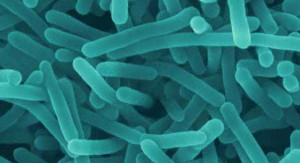 Listeriosis, a disease caused by the bacteria Listeria monocytogenes, is the third leading cause of death by food poisoning in the U.S. On average, there are 1,600 cases of listeriosis nationally each year, 260 of them deadly. The main groups affected are pregnant women, older adults, newborns and adults with weakened immune systems. The largest outbreak of listeriosis to-date occurred in 2011 and was traced to contaminated cantaloupes. In total, 147 people became ill and 33 died.
Listeriosis, a disease caused by the bacteria Listeria monocytogenes, is the third leading cause of death by food poisoning in the U.S. On average, there are 1,600 cases of listeriosis nationally each year, 260 of them deadly. The main groups affected are pregnant women, older adults, newborns and adults with weakened immune systems. The largest outbreak of listeriosis to-date occurred in 2011 and was traced to contaminated cantaloupes. In total, 147 people became ill and 33 died.
Learn more about this rare but dangerous infection and what can be done to reduce risk of a listeriosis outbreak.
The illness is acquired by eating food contaminated with the bacteria. Symptoms include diarrhea, fever, body and muscle aches, and loss of balance. In the most severe cases, listeriosis can cause blood poisoning (septicemia) and meningitis. For pregnant women, listeriosis can result in miscarriage or premature birth. Listeriosis is diagnosed through a blood or spinal fluid test and is normally treated with antibiotics.
Listeria bacteria live in soil and water and can contaminate fresh produce, uncooked meat and dairy products. The bacteria can also live in food processing and packaging machinery and can contaminate food during processing, including luncheon meats and hot dogs, smoked seafood, and cheese. NRFSP/ServSafe classes in MN include instruction on the origins of Listeria contamination and how to reduce risk.
The bacteria are killed through pasteurization and cooking. For fresh produce, however, and food that may be contaminated after being cooked or pasteurized, there are important measures that food service professionals can take to prevent an infection:
- Clean food properly. According to FDA guidelines, fresh fruits and vegetables should be thoroughly washed and dried, even if they will be peeled before consumption. Keep raw meat stored separately from other foods.
- Keep food prep areas hygienic. All cutting boards, kitchen surfaces and knives should be cleaned immediately after and in-between use. Floors and refrigerators should be cleaned regularly. Food preparers should wash hands after handling uncooked foods.
- Store foods safely. Refrigerators should be set to 40°F or below and freezers to 0°F or lower. Foods should be consumed as soon as possible after purchase.
All managers in the food service industry should consider learning more about this potentially deadly type of food poisoning and detailed prevention guidelines. Safe Food Training is certified to provide NRFSP or ServSafe in MN and every course covers prevention measures for listeriosis and other foodborne illnesses.


